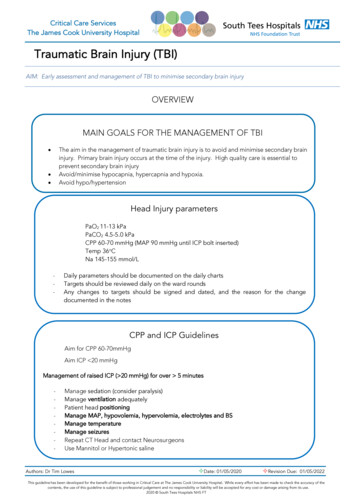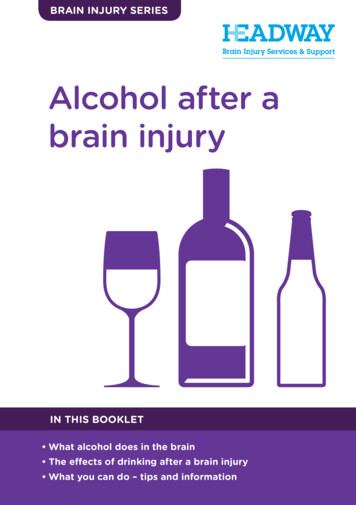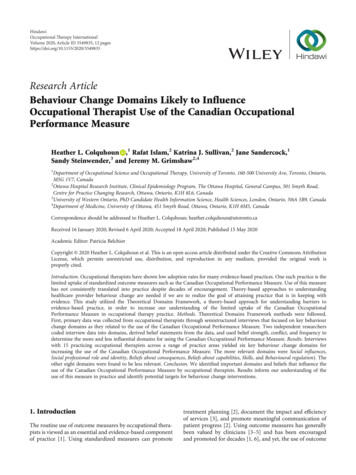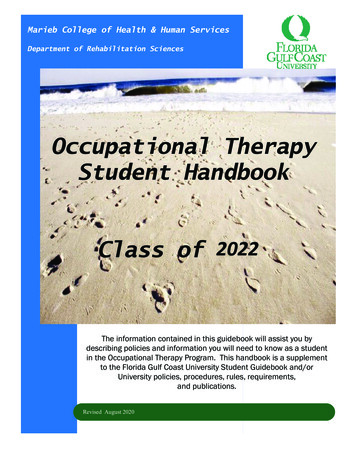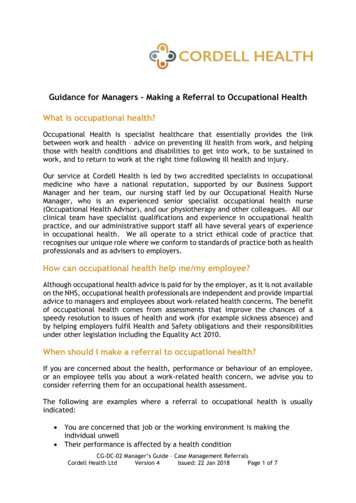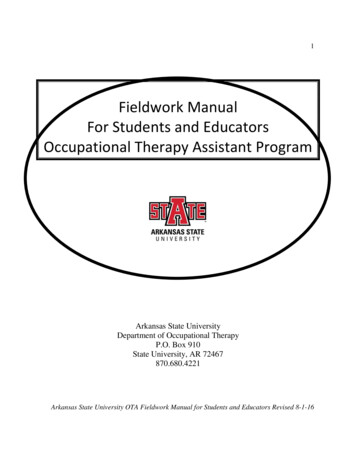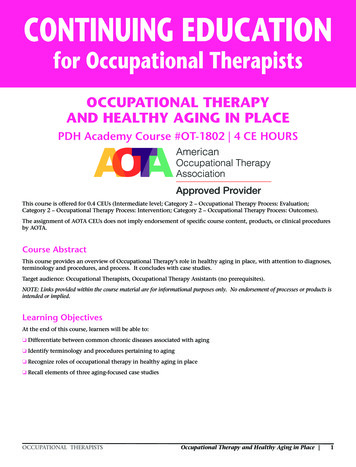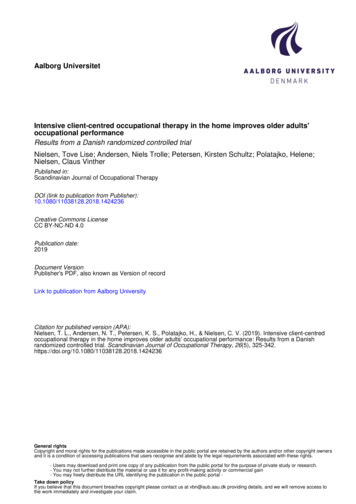
Transcription
NOIRS (National Occupational Injury Research Symposium). Preventing Workplace Injuries in a Changing World. May 10-12, 2022.
SPECIAL ACKNOWLEDGEMENTcover: NOIRS (NationalOccupational Injury ResearchAmerican Societyof Safety ProfessionalsSymposium).PreventingBoard of Certified Safety Professionals (BCSP) and BCSP FoundationWorkplace Injuries in aNational Safety CouncilChangingWorld.May 10-12,West Virginia University(WVU) Boardof GovernorsWVU2022.School of Public HealthNOIRS would not be possible without the support of our co-sponsors:WVU Benjamin M. Statler College of Engineering and Mineral ResourcesLogo: NIOSH (National Institutefor Occupational Safety andHealth).WVU Safety and Health Extension2022 NATIONAL OCCUPATIONAL INJURY RESEARCH SYMPOSIUM2
May 2022NOIRS 2022 Participants:I would like to welcome you to the 2022 National Occupational Injury Research Symposium (NOIRS 2022). We are proud ofthe high-quality scientific program supporting this year’s symposium theme, Preventing Workplace Injuries in a ChangingWorld. NOIRS is the only forum exclusively dedicated to the presentation and discussion of the latest methods, findings, andtranslation activities related to occupational acute traumatic injury research and prevention. The conference brings togetherresearchers, academicians, labor union representatives, safety professionals, industry leaders, and students from multipledisciplines and fields to advance the public health mission of keeping workers safe on the job.Now more than ever, it is evident how a changing world can impact the workplace. Many of us have adapted how and wherewe work due to the COVID-19 pandemic. Work stress and mental health concerns have expanded, and fatigue is a greaterconcern due to nonstandard schedules and increased demands. An aging workforce makes the issue of healthier workersmore pressing, and emerging technologies have transformed the work environment. What does all of this mean for how weapproach preventing workplace injuries?To address this question, the NOIRS 2022 conference agenda features emerging issues in occupational safety and cuttingedge occupational injury research findings from leading experts. Conference topics range from occupational safety during theCOVID-19 pandemic, to mental health, substance use, engineering controls for fatigue, sleep, and work hours, and industryspecific presentations related to the construction, agriculture, and public safety sectors. Special sessions will further explorethese topics and many more highlighted in the agenda below.Although NOIRS 2022 is going virtual, we hope by hosting online we can welcome more attendees who may not have beenable to join us in person. Please share your feedback via our conference evaluation link available at the end of this conferencebook.NOIRS 2022 would not be possible without the support of our co-sponsors: American Society of Safety Professionals, Boardof Certified Safety Professionals (BCSP) and BCSP Foundation, National Safety Council, West Virginia University (WVU)Board of Governors, WVU School of Public Health, WVU Benjamin M. Statler College of Engineering and MineralResources, and WVU Safety and Health Extension. Each contributed to planning the scientific program and outreach for thesymposium. Also, thanks to the National Safety Council, a special issue of the Journal of Safety Research will highlightresearch presented at NOIRS 2022.While progress is being made in reducing the toll of workplace injury and death, NOIRS 2022 provides an opportunity to reenergize our efforts to improve the safety of all workers. I offer my best wishes for a productive interchange of science andprevention strategies and the development of new partnerships as we work toward our common goal to prevent acutetraumatic injuries and fatalities in the workplace. Enjoy NOIRS 2022!John HowardDirector, National Institute for Occupational Safety and Health2022 NATIONAL OCCUPATIONAL INJURY RESEARCH SYMPOSIUM3
ACKNOWLEDGEMENTSNOIRS 2022 is being convened by the NIOSH Division of Safety ResearchDawn N. Castillo, DirectorTimothy J. Pizatella, Deputy DirectorWe gratefully acknowledge our co-sponsors for their contributions and support:American Society of Safety ProfessionalsBoard of Certified Safety Professionals (BCSP) and BCSP FoundationNational Safety CouncilWest Virginia University (WVU) Board of GovernorsWVU School of Public HealthWVU Benjamin M. Statler College of Engineering and Mineral ResourcesWVU Safety and Health ExtensionSpecial acknowledgements are made to the following for their support and dedication to planning NOIRS 2022Conference Management CommitteeTim Pizatella [Chair], Dawn Castillo,Gene Hill, Christine Schuler, Christina Socias-Morales, Rebecca Knuth, Kelly HenkinsScientific Program CommitteeChristine Schuler and Sergey Sinelnikov [Chairs]Christina Socias-Morales [Co-Chair]Angela Giotto, Gordon Smith, Jan Wachter,Hugo Camargo, James Collins, Hongwei Hsiao, Jennifer M. Lincoln, Audrey ReichardSymposium Support ServicesNOIRS WebsiteJoyce SpikerNIOSH Division of Safety ResearchSymposium Planning SupportOn Par Productions, LLC2022 NATIONAL OCCUPATIONAL INJURY RESEARCH SYMPOSIUM4
CONTENTSSPECIAL ACKNOWLEDGEMENT . 2PREFACE. 3ACKNOWLEDGEMENTS . 4CONTENTS . 5GENERAL INFORMATION . 6AGENDA AT A GLANCE . 7SESSIONS AGENDA . 9DAY 1: TUESDAY, MAY 10, 2022 . 9DAY 2: WEDNESDAY, MAY 11, 2022 . 13DAY 3: THURSDAY, MAY 12, 2022. 17OPENING AND CLOSING PLENARY SPEAKERS . 21ABSTRACTS . 31DAY 1: TUESDAY, MAY 10, 2022 . 32DAY 2: WEDNESDAY, MAY 11, 2022 . 58POSTER ABSTRACTS. 93LIST OF FEATURED POSTERS . 94DAY 3: THURSDAY, MAY 12, 2022. 103ABSTRACT AND SESSION PROPOSAL REVIEWERS. 125INDEX OF PRESENTERS. 1262022 NATIONAL OCCUPATIONAL INJURY RESEARCH SYMPOSIUM5
GENERAL INFORMATIONSymposium GoalThe goal of NOIRS is to provide a forum for researchers and other professionals to share their findings and experiencesaimed at preventing traumatic occupational injury through research and prevention. In addition to presenting currentresearch findings, NOIRS also seeks to foster collaboration among researchers from a broad range of disciplines andperspectives; showcase innovative and state-of-the-art approaches to research and prevention; demonstrate the effectivenessof transferring research results to the workplace for prevention; and promote further research that will advance the goals ofthe National Occupational Research Agenda.How to Access BizzaboGoogle Chrome is the preferred browser for accessing Bizzabo, the virtual platform for NOIRS 2022. You need to enable thirdparty cookies to access Bizzabo. See the FAQ/Troubleshooting Guide and Third Party Consent guidance for moreinformation.You can also do a Technology Check to make sure your computer, internet connection and related equipment are workingproperly before accessing Bizzabo for NOIRS 2022.Your link to access NOIRS 2022 is unique to the email address you used to register, so please do not share it withanyone else. If the link is shared, you will not be able to access the presentations during the symposium. If you did notreceive an email from Bizzabo with your unique conference link by May 9, 2022, please contact Kelly Henkins at(304) 285-5904 or ocy1@cdc.gov.How to Access the Poster SessionA one-hour poster session will take place at 4:00 p.m. on May 11, 2022. You can access the session using thePoster Session Zoom link.Meeting ID: 160 099 5398Passcode: NOIRS2022!A link to the poster session is also available on the NOIRS 2022 Bizzabo page.Questions?If you have any issues during the symposium, please contact Tim Pizatella (tjp2@cdc.gov) or Christina Socias-Morales(wzo4@cdc.gov).2022 NATIONAL OCCUPATIONAL INJURY RESEARCH SYMPOSIUM6
NOIRS 2022 AGENDA AT A GLANCEDAY 1TUESDAY – MAY 10, 202212:00 – 1:00 pmOpening Plenary SessionConcurrent Sessions A1:00 – 2:00 pmA1: Human-RobotInteraction in theWorkplaceA2: Work-Related InjuriesRelated to Substance UseA3: Research to Practice inthe Construction IndustryA4: Surveillance inAgriculture, Forestry, andFishingConcurrent Sessions B2:00 – 3:00 pmB1: Using Workers’Compensation Systems toConduct InjurySurveillanceB2: Work-Related MentalHealth Considerations toReduce InjuriesB3: Research in theConstruction IndustryPart 1B4: Special Topics inAgriculture, Forestry, andFishingConcurrent Sessions C3:00 – 4:00 pmC1: NIOSH FatalityInvestigationsC2: Occupational SafetyDuring the COVID-19PandemicDAY 2C3: Emerging ProtectiveTechnology inConstructionC4: High-Risk Workers inAgriculture, Forestry, andFishingWEDNESDAY – MAY 11, 2022Concurrent Sessions D12:00 – 1:00 pmD1: Advancing SurveillanceEfforts to Improve EMSand Firefighter H&SOutcomesD2: Occupational Stressand Work OrganizationD3: Understanding andVisualizing RecentConstruction Safety andHealth TrendsD4: Robotics inAgricultureConcurrent Sessions E1:00 – 2:00 pmE1: Occupational InjurySurveillance in the USMilitaryE2: Fatigue, Sleep, andWork hoursE3: Helmet Research onWork-Related TraumaticBrain and MusculoskeletalInjuriesE4: InterdisciplinaryApproaches Along theTranslational ResearchContinuum to ReduceChildren’s Injuries inAgricultureConcurrent Sessions F2:00 – 3:00 pmF1: Occupational InjurySurveillance, Part 1F2: Crew ResourceManagement: CriticalDecision Making in TheHazard ZoneF3: Research in theConstruction IndustryPart 2F4: All-Terrain VehicleSafety in AgricultureConcurrent Sessions G3:00 – 4:00 pm4:00 – 5:00 pmG1: Occupational Injury Surveillance,Part 2G2: Ergonomics and MusculoskeletalDisordersG3: Efforts to Document andAddress the Risk of Fatigue in theAgriculture, Forestry, and FishingSectorZoom Poster Breakout Session2022 NATIONAL OCCUPATIONAL INJURY RESEARCH SYMPOSIUM7
DAY 3THURSDAY – MAY 12, 2022Concurrent Sessions H12:00 – 1:00 pmH1: Work-Related VehicleCrashesH2: Industrial MobileRobots: Best Practices forWorker SafetyH3: Special Considerationsfor High-Risk WorkersH4: Participatory SelfManagement to PromoteSafety Culture/Climate andSustainability inHazardous WorkEnvironmentsConcurrent Sessions I1:00 – 2:00 pmI1: Use of Workers'Compensation Claims toAdvance SafetyI2: Measuring andPredicting Footwear SlipRiskI3: The Role of Worker Agein Occupational InjuriesI4: Connecting SafetyClimate/Culture to SafetyManagement: A BriefSummaryConcurrent Sessions J2:00 – 3:00 pm3:00 – 4:00 pmJ1: New Bureau of Labor StatisticsOffice of Safety and Health ProgramMethods and ApproachesJ2: Laboratory Studies to ReduceWork-Related InjuriesJ3: Special Topics in Work-RelatedInjuriesClosing Plenary Session and Remarks2022 NATIONAL OCCUPATIONAL INJURY RESEARCH SYMPOSIUM8
NOIRS 2022 SESSIONS AGENDADAY 1: TUESDAY, MAY 10, 202212:00 – 1:00 pmOPENING PLENARY SESSIONPreventing Workplace Injuries in a Changing WorldOpeningDawn N. Castillo, MPHDirector, Division of Safety ResearchNational Institute for Occupational Safety and HealthPlenary SpeakersJohn M. Howard, MDDirectorNational Institute for Occupational Safety and HealthLorraine M. Martin, MSPresident and CEONational Safety CouncilRon Gantt, M Eng, CSPDirector and Principal ConsultantReflect Consulting GroupChristopher J. Martin, MD, MScDirector, Occupational Medicine Residency ProgramWest Virginia UniversityDiscussion2022 NATIONAL OCCUPATIONAL INJURY RESEARCH SYMPOSIUM9
1:00 – 2:00 pmCONCURRENT SESSIONS AA1Human-Robot Interaction in the WorkplaceModerator: Hongwei Hsiao1:00A1.1Safety Challenges of Human-Robot Interaction at the Future of Construction WorkIdris Jeelani1:15A1.2Real-Time Adjustment of Moving Trajectories for Collaborative Robotic DevicesMarvin Cheng1:30A1.3Assessing Challenges and Technology Needs for Safe Self-Escape from Underground Coal MinesEugene GyawuA2Work-Related Injuries Related to Substance UseModerator: Hope Tiesman1:00A2.1Census of Fatal Occupational Injuries (CFOI): 10 years of Drug and Alcohol Surveillance Pilot DataChristen Byler1:15A2.2Opioid Overdose Deaths by Worker Industry Groups and Demographic Characteristics,United States, 2007-2014Andrea Steege1:30A2.3Investigating the Shooting Death of a Firefighter Who Responded to an Opioid OverdoseStephen Miles & Sophia ChiuA3Research to Practice in the Construction IndustryModerator: Scott Earnest1:00A3.1Stand-Downs to Raise Awareness and Prevent Fatalities in ConstructionElizabeth Garza1:15A3.2Identifying Common Root Causes of Work-Related Falls from Heights Through Self-ReportedData from Individuals Who Experienced, Witnessed, or Investigated Fatal and Nonfatal FallsJessica Bunting1:30A3.3Behavioral Economics in the Construction Industry: Use of Choice Architecture Techniques toAccelerate Acceptance and Adoption of Health and Safety Research Findings and SolutionsSue Ann SarpyA4Surveillance in Agriculture, Forestry and FishingModerator: KC Elliott1:00A4.1Challenges in Regional Surveillance for Commercial Fishing Injuries: The Utility of StateTrauma Registry DataViktor Bovbjerg1:15A4.2Fatal Agricultural Injuries in Florida: Building an Injury Surveillance SystemSerap Gorucu1:30A4.3Using Machine Learning on Pre-Hospital Care Report Data to Identify OccupationalInjuries in AgricultureErika Scott2022 NATIONAL OCCUPATIONAL INJURY RESEARCH SYMPOSIUM10
2:00 – 3:00 pmCONCURRENT SESSIONS BB1Using Workers’ Compensation Systems to Conduct Injury SurveillanceModerator: Steven Wurzelbacher2:00B1.1How Workers' Compensation Claims Can Inform Health and Safety in the LandscapingServices IndustryBarbara Alexander2:15B1.2Construction Industry Workers’ Compensation Injury Claims Due to Slips, Trips, and Falls –Ohio, 2010-2017Christina Socias-Morales2:30B1.3Workers’ Compensation Injury Claims Among Firefighters in Ohio, 2001-2017Tyler QuinnB2Work-Related Mental Health Considerations to Reduce InjuriesModerator: Eric Carbone2:00B2.1Circumstances Contributing to Construction Worker Death from SuicideJonathan Davis2:15B2.3Suicides Among First Responders National Violent Death Reporting System, 27-37U.S. States or Territories, 2015-2017Leslie CarsonB3Research in the Construction Industry Part 1Moderator: Douglas Trout2:00B3.1Job Hazard Analysis in Construction: Challenges and SolutionsBabak Memarian2:15B3.2Assessing the Potential of Passive Exoskeletons in ConstructionCarisa Harris Adamson2:30B3.3Construction Trainer and Trainee Perspectives on the Quality and Effectiveness of theOSHA 10 Construction CourseMark FullenB4Special Topics in Agriculture, Forestry and FishingModerator: KC Elliott2:00B4.1Confined Space: Reducing Grain Bin Related Injuries and FatalitiesLinda Fetzer, Michael Dyer & Serap Gorucu2:15B4.2Epidemiology of Diving-Related Fatalities in the U.S. Commercial Fishing IndustrySamantha Case2:30B4.3Slips, Trips and Falls in the Pacific Northwest Commercial Fishing IndustryLaurel Kincl2022 NATIONAL OCCUPATIONAL INJURY RESEARCH SYMPOSIUM11
3:00 – 4:00 pm4:00 pmCONCURRENT SESSIONS CC1NIOSH Fatality InvestigationsModerator: Jeffrey Funke3:00C1.1Case Study: One Firefighter Dies and Another Injured in High Pressure Natural Gas LineExplosion – NIOSH Fire Fighter Fatality Investigation and Prevention ProgramKaris Kline-Field3:15C1.2Fatality Assessment and Control Evaluation (FACE) Program – Law Enforcement OfficerStruck-by Fatality InvestigationsMelanie FowlerC2Occupational Safety During the COVID-19 PandemicModerator: Lisa Steiner3:00C2.1How COVID-19 Changed Law Enforcement: Voices from Those who ServeYoon-Sung Nam3:15C2.2COVID-19 Perceptions and Practices Among Agricultural Producers and Stakeholders: The Needfor Tailored Communication CampaignsJosie Rudolphi3:30C2.3Response to the COVID-19 Pandemic in the Construction IndustryDouglas TroutC3Emerging Protective Technology in ConstructionModerator: Justin Haney3:00C3.1Effects of Wearing Unpowered Upper and Lower Body Exoskeletons on Visual AttentionalPerformance During Simulated Overhead and Squatting Peg-in-Hole TasksHeeSun Choi3:15C3.2Suspension Systems with Air-Bubble Cushioning Liner for Improved Shock AbsorptionPerformance of Type I Industrial HelmetsJohn Wu3:30C3.3Characterization of Shock Absorption Performance of Construction Helmet in Top ImpactsChris PanC4High-Risk Workers in Agriculture, Forestry and FishingModerator: Miranda Dally3:00C4.1Injury and Severity in Greenhouse and Nursery Workers: Using Data and Collaboration to DrivePrevention Through Engineering DesignKatherine Schofield3:15C4.2A Pilot Study of Personal Risk Factors Moderating the Relationship Between Occupational HeatExposure and Injury RiskMiranda Dally3:30C4.3Timber-Safe – Reduction of WV Logging Hazards through the Implementation of a LoggingOperations Safety and Health Management SystemMark FullenAdjourn Day 12022 NATIONAL OCCUPATIONAL INJURY RESEARCH SYMPOSIUM12
DAY 2: WEDNESDAY, MAY 11, 202212:00 – 1:00 pmCONCURRENT SESSIONS DD1Advancing Surveillance Efforts to Improve EMS and Firefighter H&S OutcomesModerator: John H. Oates12:00D1.1EMERG-ing Data - Multi-City Surveillance of Violence Against EMS RespondersJennifer A. Taylor12:15D1.2Descriptive Epidemiology of the Fire Service Organizational Culture of Safety (FOCUS)Beta-Test Data: Differences by Safety ClimateAshley Geczik12:30D1.3Firefighter Exposure Tracking: Challenges and OpportunitiesDavid BernzweigD2Occupational Stress and Work OrganizationModerator: Douglas Myers12:00D2.1Passive Safety Leadership, Stress, Anxiety and Diminished Firefighter Safety Behavior OutcomesTodd Smith12:15D2.2Safety Climate and Noncombat Injury Events Among United States Air Force WorkersChristina Socias-Morales12:30D2.3Psychological Strains as Mediators of the Relationship Between the Work Environmentand Work InjuriesNathan BowlingD3Understanding and Visualizing Recent Construction Safety and Health TrendsModerator: Richard Rinehart12:00D3.1Visualizing and Disseminating Data on Fatal and Severe Injuries in the U.S. Construction IndustryWilliam Harris12:15D3.2Mental Health Among Construction Workers in the United StatesSamantha Brown12:30D3.3Prescription Opioid Use and Stigmatized Attitudes Among Apprentice Construction WorkersAnn Marie DaleD4Robotics in AgricultureModerator: Jennifer M. Lincoln12:00D4.1Literature Review: Does Improved Agriculture Technologies Mean Improved Safety?Darlene Weaver12:15D4.2Livestock Technology Review - Application to Worker Safety & HealthMarie Hayden12:30D4.3Severe Occupational Injuries from Food Packaging and Movement in the U.S. Supply ChainJudd Michael2022 NATIONAL OCCUPATIONAL INJURY RESEARCH SYMPOSIUM13
1:00 – 2:00 pmCONCURRENT SESSIONS EE1Occupational Injury Surveillance in the U.S. MilitaryModerator: Melody Gwilliam1:00E1.1Beginning to Grasp Finger, Hand and Wrist Injuries in the U.S. Air ForceMelody Gwilliam1:15E1.2Estimated Costs of Lower Extremity Fractures Among U.S. Army SoldiersMichelle Canham-Chervak1:30E1.3The Impacts of the Transition to ICD-10-CM on U.S. Army Injury SurveillanceAnna Schuh-RennerE2Fatigue, Sleep and Work HoursModerator: Karl Sieber1:00E2.1Assessing the Impact of Work Hours on Worker Safety and Health in the Stone, Sand andGravel Mining IndustryTodd Smith1:15E2.2Findings from a Systematic Review of Fatigue Interventions in Industrial SettingsZoe Dugdale1:30E2.3Survey of Working and Sleeping Time by Industry and Occupation of Fulltime Workersin the U.S.Guang ChenE3Safe Helmet Research on Work-Related Traumatic Brain and Musculoskeletal InjuriesModerator: Chris Pan1:00E3.1Assessment of Fall Protection Performance of Type I Industrial HelmetsChris Pan1:15E3.2Evaluation of Hard Hats for the Reduction of Head Injuries due to FallsSteve Rowson1:30E3.3Designing a Safe Envelope of Weight and Center of Gravity of Firefighting Helmet ThroughBiomechanical Measurements and ModelingSuman ChowdhuryE4Interdisciplinary Approaches Along the Translational Research Continuum to Reduce Children’sInjuries in AgricultureModerator: Florence Becot1:00E4.125 Years of Progress and Persistent Challenges in Childhood Agricultural SafetyBarbara Lee1:15E4.2Surveillance of Medically Attended Agricultural Injuries in Farm ChildrenJeffrey VanWormer1:30E4.3Agricultural Youth Work GuidelinesAndrea Swenson2022 NATIONAL OCCUPATIONAL INJURY RESEARCH SYMPOSIUM14
2:00 – 3:00 pmCONCURRENT SESSIONS FF1Occupational Injury Surveillance, Part 1Moderator: Audrey Reichard2:00F1.1Time Series, Seasonality and Trend Evaluation of 6-Year (2015-2020) OSHA Severe Injury DataHarold Gomes2:15F1.2Using Multiple Surveillance Systems to Understand Potential SARS-Co-V-2 Exposures AmongEMS and FirefightersEmily Haas2:30F1.3SOII vs. MarketScan: What Can Alternative Data Tell Us About the Seasonality of Injuries?Benjamin RaymondF2Crew Resource Management: Critical Decision Making in the Hazard ZoneModerator: Murrey Loflin2:00Presenters: Dennis L. Rubin, Murrey LoflinF3Research in the Construction Industry Part 2Moderator: Scott Earnest2:00F3.1Improving Residential Construction Safety Through Safety Leadership andFall Prevention TrainingBradley Evanoff2:15F3.2Development of a Mast Climbing Work Platform Visual Inspection ToolBryan Wimer2:30F3.3Highlights from the CPWR Small Studies Program and Future Priorities and OpportunitiesRichard RinehartF4All-Terrain Vehicle Safety in AgricultureModerator: Christine Schuler2:00F4.1ATV Safety Design Features: Examining Cultural Awareness and Piloting an Educational ProgramAmong U.S. Young Adults in AgricultureJenna Gibbs2:15F4.2Protecting Farmworkers in Agricultural All-Terrain Vehicle Rollover IncidentsFarzaneh Khorsandi2:30F4.3Evaluating Youths' Capability to Ride Agricultural All-Terrain Vehicles Using ComputerSimulationsGuilherme De Moura Araujo3:00 – 4:00 pmCONCURRENT SESSIONS GG1Occupational Injury Surveillance, Part 2Moderator: Kitty Hendricks3:00G1.1A Time Series Analysis of Nonfatal Occupational Injuries Treated in United States EmergencyDepartments from 2012 to 2019Eric Lundstrom2022 NATIONAL OCCUPATIONAL INJURY RESEARCH SYMPOSIUM15
3:15G1.2Surveillance of Acute Nonfatal Occupational Inhalation Injuries Treated in US HospitalEmergency Departments, 2014-2017Kitty Hendricks3:30G1.3Severe Injuries in the Oil and Gas Industry: An Analysis of OSHA’s Severe Injury ReportingSystem from 2015-2020Vidisha ParasramG2Ergonomics and Musculoskeletal DisordersModerator: Bradley Evanoff3:00G2.1Use of a Job Exposure Matrix to Study Both Recent and Past Work Exposures on the Incidence ofCarpal Tunnel Release Surgery in the CONSTANCES CohortBradley Evanoff3:15G2.2Iterative Design of Novel Aerosol Containment Hood Using Ergonomic AssessmentKatrina Cernucan3:30G2.3Occupational Demands Associated with Rotator Cuff Disease Surgery: Results from a NovelLinkage of a Job-Exposure Matrix to the U.K. BiobankElizabeth YanikG3Efforts to Document and Address the Risk of Fatigue in the Agriculture, Forestry and Fishing SectorModerator: David Douphrate3:00Presenters: KC Elliott, Jeff Levin, Athena K. Rowan, Erika Scott, Julie Sorensen, Laurel Kincl, and Leigh McCue4:00 – 5:00 pmZoom Poster SessionModerator: Christina Socias-MoralesP1Response Time Following Local Vibration in Tasks Mimicking Truck Drivers PerformanceJuan Manuel CastelloteP2A Mixed-Methods Approach to Examining Safety Climate Among Truck DriversEmily Yueng-Hsiang HuangP3Accidents in the Truck Driver Sector and the Health Paradox of this Demanding OccupationJuan Manuel CastelloteP4A Hard Day’s Night: Shift Work, Fatigue and Cardiovascular Risk Factors Among Maine’sLogging WorkforceErika ScottP5Investigation of a Fatality that Occurred when a Logging Processor Lost Traction and RolledDown a HillsideJennifer E. Lincoln & Jeff R. FunkeP6The NIOSH Fatality Assessment and Control Evaluation (FACE) Program – Law EnforcementOfficer Motor Vehicle Fatality InvestigationsMelanie FowlerP7Use of the CDC’s Social Vulnerability Index to Characterize Firefighters’ and Medical FirstResponders’ Potential Exposure to SARS-CoV-2 During Routine Emergency ResponsesAlexa Furek2022 NATIONAL OCCUPATIONAL INJURY RESEARCH SYMPOSIUM16
5:00 pmP8Reliability and Validity of a Safety Hazard and Management Assessment QuestionnaireLibby MooreP9Workplace Violence Training among Young Workers 14–24 Years of Age in the U.S.Camryn LopezP10Perceptions of Workplace Hazards in a Sample of West Virginia Sawmill EmployeesWayne LundstromP11Polypropylene Honeycomb in Industrial Safety HelmetsShengke ZengP12What’s Stopping You? Organizational Constraints as a Multi-Facet Work StressorNathan BowlingAdjourn Day 2DAY 3: THURSDAY, MAY 12, 202212:00 – 1:00 pmCONCURRENT SESSIONS HH1Work-Related Vehicle CrashesModerator: Eva Shipp12:00H1.1Driver Injuries in Heavy vs. Light and Medium Truck Local Crashes, 2010- 2019Terry Bunn12:15H1.2Trends in Work-Related Fatalities Due to Motor Vehicle Crashes, United States, 2011–2019Srinivas Konda12:30H1.3Lessons Learned from Using Crash Records for Injury Surveillance in the AFF SectorEva ShippH2Industrial Mobile Robots: Best Practices for Worker SafetyModerator: Carole Franklin12:00Presenters: Carole Franklin, Mark Lewandowski, Jeremy Marvel, Aaron Prather, Federico VicentiniH3Special Considerations for High-Risk WorkersModerator: Tamara Small12:00H3.1Promoting Safety and Well-Being Among Sheet Metal Worker Women Through MentoringMarissa Baker12:15H3.2Evaluating the Accidents and Level of Compliances in Construction SitesSomendra Rana12:30H3.3Revisiting Formative Research to Identify Gaps in Hazard Recognition Research forHigh-Risk WorkersBrianna EiterH4Participatory Self-Management to Promote Safety Culture/Climate and Sustainability in HazardousWork EnvironmentsModerator: Ted Scharf2022 NATIONAL OCCUPATIONAL INJURY RESEARCH SYMPOSIUM17
12:00H4.1A Brief History of Worker Engagement in Safety InitiativesLisa Kath12:12H4.2“Non-compliance,” “Complacency,” and Other Explanations for Unsafe Work Practices thatBlame Workers for Systemic Failures: One Psychologist’s PerspectiveTed Scharf12:25H4.3The Promise Of, and Problems With, Worker ParticipationScott Schneider12.37H4.4Using Close Call Reports to Empower Worker-Led InterventionsEmily Haas12:501:00 – 2:00 pmDiscussionDavid LeGrandeCONCURRENT SESSIONS II1Use of Workers' Compensation Claims to Advance SafetyModerator: Steven Naber1:00I1.1The Impact of a State-Based Workers’ Compensation Insurer’s Risk Control Services on EmployerClaim Frequency and Cost RatesSteven Wurzelbacher1:15I1.2Surveillance of Agricultural Injuries: Comparison of State Trauma and Workers' CompensationData SourcesMarizen Ramirez1:30I1.3Workers’ Compensation Claim Counts and Rates by Injury Event/Exposure Among State-InsuredPrivate Employers in Ohio, 2007-2017Steven WurzelbacherI2Measuring and Predicting Footwear Slip RiskModerator: Jennifer Bell1:0012.1A Portable Device for Measuring Shoe-Floor Coefficient of Friction in SituKurt Beschorner1:1512.2Predicting Footwear Slip Risk Using a Low-Cost, Portable, Shoe Tread ScannerSarah Hemler1:3012.3Predicting the Friction Performance of Footwear Based on Outsole FeaturesKurt BeschornerI3The Role of Worker Age in Occupational InjuriesModerator: James Collins1:0013.1Risk of Work-Related Reinjury Among Older Workers With and Without a Work-RelatedPermanent Impairment: Are Work-Related Injury Rates Differentially Underestimated forWorkers Aged 65 and Older?Jeanne Sears1:1513.2Environmental Factors of Ladder Overreaching in Older AdultsDavid Williams2022 NATIONAL OCCUPATIONAL INJURY RESEARCH SYMPOSIUM18
1:3013.3I4Connecting Safety Climate/Culture to Safety Management: A Brief SummaryModerator: Ted Scharf1:00Presenters: Ted Scharf, Lisa M. Kath, and Emily J. Haas2:00 – 3:00 pmTraumatic Injuries and Fatalities Among Young Workers in Alaska: 2014-2018Richard EvoyCONCURRENT SESSIONS JJ1New Bureau of Labor Statistics Office of Safety and Health Program Methods and ApproachesModerator: Elizabeth Rogers2:00Presenters: Daniel Friel, Julie Krautter, Christen Byler, and Imani Drayton-HillJ2Laboratory Studies to Reduce Work-Related InjuriesModerator: Jen
Logo: NIOSH (National Institute for Occupational Safety and Health). SPECIAL ACKNOWLEDGEMENT . NOIRS 2022 is being convened by the NIOSH Division of Safety Research . Dawn N. Castillo, Director . Timothy J. Pizatella, Deputy Director . showcase innovative and state-of-the-art approaches to research and prevention; demonstrate the .
